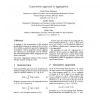Free Online Productivity Tools
i2Speak
i2Symbol
i2OCR
iTex2Img
iWeb2Print
iWeb2Shot
i2Type
iPdf2Split
iPdf2Merge
i2Bopomofo
i2Arabic
i2Style
i2Image
i2PDF
iLatex2Rtf
Sci2ools
116
Voted
EUSFLAT
2001
2001
A geometric approach to aggregation
In analogy to the representation of the standard probabilistic average as an expected value of a random variable, a geometric approach to aggregation is proposed. Several properties of such aggregation operators are investigated, and the relationship with distinguished classes of aggregation operators is discussed. Key words. Aggregation operator, fuzzy measure, Choquet integral, triangular norm. In both cases, the surface of the endograph of a non-increasing function hmVf: [O,11 + [O,1] given by h,, (t) = m({f 2 t)) is computed, where m is a (a-additive) measure and f represents the input to be aggregated. We generalize (1) and (2), replacing the aadditivity of the measure by significantly weaker properties. This will lead to a rather general class of geometrical aggregation operators, and many distinguished classes of aggregation operators are special cases thereof.
Aggregation Operators | Distinguished Classes | EUSFLAT 2001 | EUSFLAT 2007 | Standard Probabilistic Average |
Related Content
| Added | 31 Oct 2010 |
| Updated | 31 Oct 2010 |
| Type | Conference |
| Year | 2001 |
| Where | EUSFLAT |
| Authors | Erich-Peter Klement, Radko Mesiar, Endre Pap |
Comments (0)

